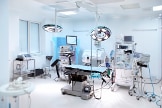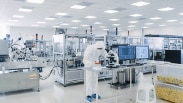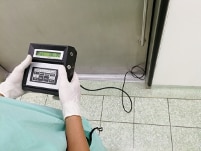Many Types of Clean and Isolation Rooms
There are many clean room applications where consistent air pressure and/or an extremely clean air environment is required. These purposes range from healthcare to manufacturing to technology R&D. Examples include:
- Hospital isolation rooms
- Hospital operating rooms
- Hospital critical care units
- Pharmaceutical plants
- Toxic waste isolation tents
- Biological labs
- Wafer fabrication facilities
- Electronic products manufacturing plants
- R&D laboratory clean rooms
Some of the above applications require that a room maintain a higher or lower pressure compared to its ambient environment. If the isolated room has higher air pressure, it is considered a posititive pressure room. If the isolated room has lower air pressure, then it is a negative pressure room.
In a positive pressure room, air from the room can escape while outside air cannot enter. This is accomplished by having fans or filters blow air into a properly sealed room in lieu of air from the ambient environment. This prevents contamination from the ambient environment to enter the room. Positive air pressure is common in pharmaceutical plants, wafer fabrication facilities, laboratory facilities, hospital operating rooms, etc.

Figure 1 – Hospital Operating Room
In contrast, negative pressure rooms maintain lower air pressure than the adjacent environment through a ventilation system. This ventilation system is designed so that ambient air can enter the room but air from within the room is forced out to a certain destination. These types of isolation rooms are typical in hospital enviroments where the patient is suffering from airborne communicable diseases such as Covid-19 and tuberculosis. These types are rooms are also used to control the spread of dangerous chemicals in labs and factories. Negative pressure rooms are extremely important to protect staff, other patients and to halt the general spread of diseases or other contaminants.
Extending beyond air pressure, many laboratories and manufacturing facilities require a clean production environment where airborne particles, humidity, temperature and air flow can be measured and controlled. These facilities must maintain specific parameters to ensure that environmental conditions don’t compromise product research, development or production. Since, 2001 these clean rooms are rated based on the ISO 14644-1 standard that classifies them on the maximum acceptable number of particles by size in the air, per cubic meter.

Figure 2 – R&D Clean Room
The Role of Differential Pressure Sensors in Clean and Isolation Rooms
Differential pressure sensors measure the difference in air pressure or air particles from two different sources. As such, differential pressure sensors play a critical role in clean rooms and similar applications where maintaining strict pressure differentials is essential to preventing contamination. For examples, changes in either pressure or air quality when someone enters a positive pressure room can impact the effectiveness of what is being examined.
As the purpose of the clean room is to maintain a fixed air pressure and/or eliminate contamination by dirt particles, some of which potentially contain microorganisms or toxins, measuring accurate differential pressure levels ensures clean rooms work as intended. As such, it is essential to carefully measure and monitor pressure both inside and outside of the clean room to confirm the differential remains within the acceptable range.
However, as with most electromechanical devices differential pressure sensors are sensitive to many external factors including noise, humidity, temperature and physical positioning. Differential pressure sensors that reduce the impact of external factors will provide the most accurate differential readings for ensuring clean and isolation room effectiveness.
Superior Sensor’s Technology Advantage
Superior Sensors’ proprietary NimbleSenseTM architecture is the industry’s first System-in-a-Sensor integrated platform. Incorporating a highly differentiated advanced pressure sensing system with the ability to integrate optional building blocks enables us to combine the highest accuracy and reliability with application exclusive features. With unique technology deployed in our HV and ND Series of differential pressure sensors, Superior’s products offer many advantages for clean rooms, isolation rooms and othern air quality applications.
Highest Levels of Accuracy
Sensor accuracy is critical when ensuring clean rooms and isolation rooms are sealed correctly. Being able to determine even the smallest of leaks is important when either guaranteeing a clean manufactuting/lab environment or isolating airborne contaminants. Superior’s HV and ND Series of differential pressure sensors have the industry’s leading accuracy to as close as within 0.05% of the selected range, total error band (TEB) within 0.15% of FSS and long-term stability within 0.15% of FSS per year.
Lowest Noise Floor
External noise can have a negative impact on the accuracy and performance of differential pressure sensing systems. Utilizing our integrated advanced digital filtering technology, Superior’s pressure sensors eliminate the noise created by these factors prior to their reaching the sensor sub-system. Thus, the noise is eliminated before it becomes an error signal that can lead to inaccurate readings.

Figure 3 – Measuring Air Pressure to Verify Seal Integrity
Position Insensitivity
Extremely beneficial for handheld applications such as room/building seal integrity testing, Superior’s unique dual-die implementation with the HV210 and ND210 sensors maintains consistent and highly accurate readings regardless of physical orientation of the differential pressure sensing device. Rated with a positional sensitivity to within 0.25 Pa, the HV210 and ND210 are industry leaders with respect to position insensitivy.
Integrated 50/60Hz Notch Filter
As all of Superior’s pressure sensors have an extremely low noise floor, power line interference can be ‘heard’ when taking measurements. The integrated 50Hz/60Hz notch filter eliminates this noise so you maintain the advantage of having such a low noise floor pressure sensor without any external interference. For more details, read the 50/60Hz Notch Filter blog post.
Fastest Warm-up and Response Times
For time critical applications, warm-up time is important. The ND Series essentially eliminates warm-up time as the device is ready in just 80 msec. In addition, the amount of time it takes the pressure sensor to update its measurement data is just as vital. The faster you receive updated pressure measurements, the more accurate your differential readings. While user configurable, Superior’s ND sensors support update rates as fast as 2.25 msec.
Conclusion
Clean rooms and isolation rooms are dependent on differential pressure sensors for both positive and negative pressure rooms. They need to be able to maintain consistent air pressure and/or an extremely clean air environment in order to be effective. Rapid, accurate pressure measurements confirm that seals are tight and there is no leakage of air or contaminants.
Superior Sensor’s unique differential pressure sensor technology, based on our proprietary NimbleSense architecture, provides many differentiating features for providing the most reliable clean rooms and isolation rooms. For more detailed information about our solutions, please visit our HV Series product page, ND Series product page or contact us.

